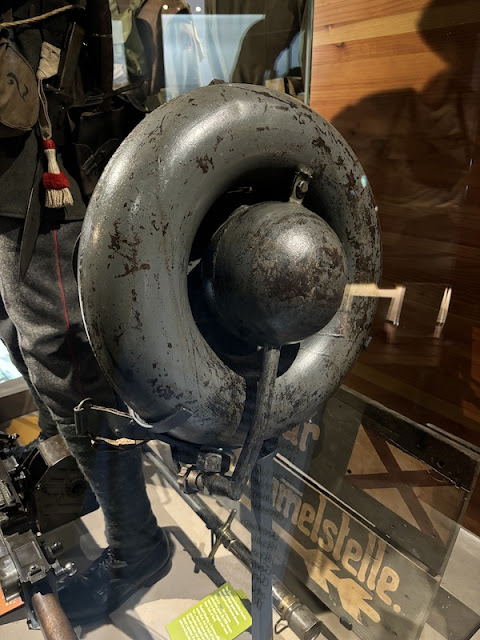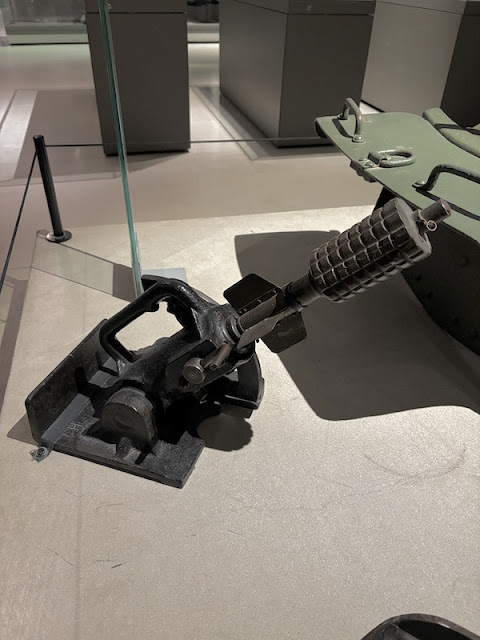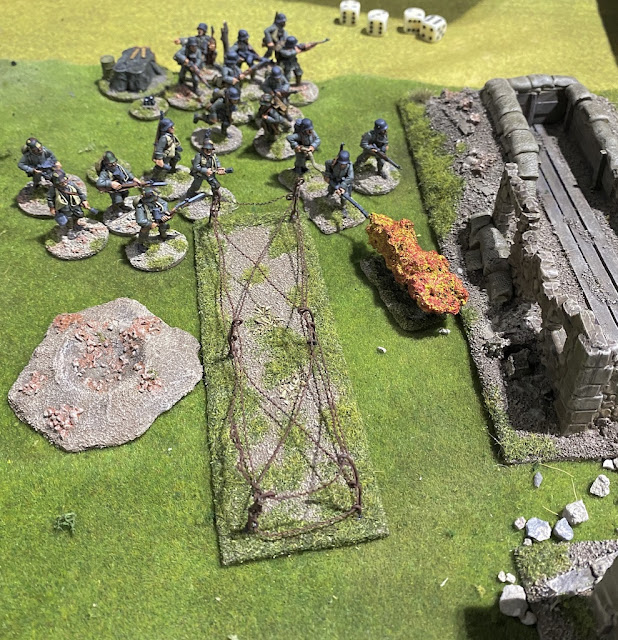My interest in the First World War is particularly focussed on the period 1916-18. It's a time of total war on an industrialised scale. The armies of all sides were struggling to find a way to fight, not least of which was finding a solution to breaking the deadlock of trench warfare. The innovation and change that it generated tends to run contrary to the popular perception of bumbling chateau generalship and futile frontal assaults. For someone interested in military history, I find it a rich period to explore. No surprise then that my collection for the First World War is focussed on that later period.
I've put together units that provide sufficient figures for platoon level actions. Unlike my Second World War collection, these are all in 28mm, a scale I find works well for the relatively close actions of the period. My German figures all come from the Great War Miniatures range.

I really do like these sculpts, they are full of character. While their British range are very good, I think the Germans are my favourites.

\
No German force from this period would be complete without Stosstruppen and I've added enough of those to mix in with the regular infantry to make up a full platoon.

The aim with the stormtroopers is to have sufficient to substitute for about half the figures in a regular infantry, enough to make it look more like Stosstruppen than regular infantry. I didn't really feel the need to have a duplicate platoon.

The Imperial War Museum has a good example of a storm trooper's equipment, including the converted sandbags used to carry additional grenades.
My intention is to use these to play Through the Mud and Blood from Too Fat Lardies. I'm also interested in a variant they published in one of their Specials entitled 'CoCing up the Mud and Blood' which merged elements of Chain of Command with Through the Mud and Blood. As it happens, the origin of Chain of Command lay in a request for the Lardies to create a Second World War version of Through the Mud and Blood. What started as an adaptation finally morphed into Chain of Command as we know it today, an entirely new rule set altogether and one I particularly like. So I'll be intrigued to see how that variant works.
Those rules, as with these figures, are more suited to reflecting the units and combat during 1916-18. That period of great tactical development saw the shape and composition of the infantry platoon in all armies transform considerably from the organisation in 1914. The German platoon is generally made up of four squads, with between eight and ten men in each, sometimes these squads will be composed of two teams each, one of riflemen and an LMG team; at other times it had a specialist grenade squad and at others a specialist LMG squad. Given the variation, I've tried to put together enough figures to cover most options.
The men are led by a mix of NCOs and junior officers. I've based these on slightly larger bases than the riflemen and in some cases added terrain items to help record the leader's command initiative level.
Here is a ten man rifle squad, including two grenade specialists and the squad's NCO.
The Germans developed their own LMG, although to use the term 'light' might be overly generous, it was a bulky weapon based on the MG08 machine gun. Here is an LMG squad - essentially the MG08/15 gunner and his assistant with a group of riflemen to serve as ammunition carriers.
There is often talk about the German MG08/15 being considerably heavier or bulkier than the Lewis Gun, the British counterpart. The Australian Infantry Museum has these two on display side by side and in terms of size they are almost identical, although admittedly the MG08/15 does weigh more.
The Germans captured quite a number of Lewis guns which they put into service after making modifications and Great War Miniatures include one of these in their German LMG set.
Talking of machine guns in general, no First World War collection would be complete without at least one of these and here is the mounted MG08.
The Australian Infantry Museum also has one of these on display.
As does the Musee de l'Armee in Paris.
The stormtroopers from Great War Miniatures look splendid and many are festooned with sandbags brimming with grenades. I've gone for the camouflage helmet look with many of these.
Of course, having said the platoon is completed, what I really mean is the core platoon - there will always be more to add by way of supports for specific scenarios.
Here are a couple of snipers. I particularly like the figure in the cape and full face armour, he looks very medieval.
While the image below is not of a German cape but a British one on display at the Imperial War Museum it gives a good indication of the sort of things worm by snipers.
Similarly this one one on display at the Musee de l'Armee is a French version.
The flamethrower was a particularly vicious invention but perfectly suited to its role in trying to clear out trenches.
There is a German flamethrower on display at the Imperial War Museum, however this one is the ‘lifebuoy’ design, rather than the one represented by Great War Miniatures.
However, I noted that the hose and projector were virtually identical.
High trajectory weapons like mortars offered another solution to trench warfare and the grenatenwerfer was a simple, platoon based grenade projector.
Below is one at the Musee de l'Armee.
The emergence of British armour called for a German response, one of which was a dedicated anti-tank rifle:
Those provide a few of the most common supports that I'm likely to be using at this stage of the war.
Heavier support comes in the form of a 77mm field gun:
There is one in the collection of the Australian Armour and Artillery Museum.
I've seen another in the Army Museum in Valencia in Spain.
And another in the Musee de l'Armee.
Last, but not least, there are a few casualty figures, something I like to use to illustrate the action for the AARs I write for this blog.
The remaining figures in the paint queue include a handful of infantry wearing gas masks, but for now I have enough Germans to make up a platoon.
The British platoon is also composed of figures from Great War Miniatures and they match the Germans for size and the character of the sculpts.
With the painted Germans now added to the British platoon the project is really starting to come to fruition. It's been a long time coming but I'm finally getting there.
I was able to use these to run four participation games at CanCon in January 2024 using the First World War Chain of Command variant. The scenario featured a March 1918 German assault on a lightly held British rearward position.
The games played out very well and the scenario was balanced enough to give either side a chance of victory which was reflected in the even outcome of two games apiece.




















































Great looking figures and you have painted them very well. Super impressive.
ReplyDeleteThe table looks great as well.
Thanks Ben, I have to say they are lovely sculpts which made them a pleasure to paint.
DeleteSuperb work, really well done, the figure look great and the table is a cracker!
ReplyDeleteThank you. I'd like to say the figures were so nicely sculpted they almost painted themselves, if only it had been that easy!
DeleteThe figures look great, the exaggerated sculpts really do give them a character all of their own. I have doubts about playing the period so I’m very much looking forward to a AAR to get the feel of it. What with Rommel’s Infantry Attack and the US Army’s Infantry in Battle books (if I got those titles right) there’s plenty of dynamic little actions for scenarios… or campaigns?
ReplyDeleteThanks Rob. So far the games have played well and much depends on what aspect of the war you want to focus on. The platoon structure for both British and German makes for a tactical unit not dissimilar to later counterparts which means at a platoon level you are in effect operating fire teams. With various squads housing 'specialists' you see an interesting interaction between those teams. Playing after March 1918 you have great fluidity in movement. Even in the more static period you see interesting developments like the 1917 British platoon, very much designed for fire and movement to take out objectives like German bunkers.
DeleteDo treat us to an AAR sometime soon. BTW apart from Rommel's attacks being in the plural I did get the titles right. Do you have the German 3.7cm anti-tank gun set? The Brits seem rather lacking in support weapons by comparison.
DeleteReally nicely done!
ReplyDeleteThank you......whoever you are!
DeleteIiRC Sonicsledgehammer is working on a full ww1 coc with lardy blessing. Bet he wouldn't mind some playtesters.
ReplyDeleteI think you mean Alex at Storm of Steel? In which case, yes I’m aware and he has been generous enough to share some of his draft rules with me (although to be honest I’ve not had a chance to play test them yet).
DeleteThat's was it!
DeleteSplendid work Sir!
ReplyDeleteThanks Phil!
Deletegreat showcase of the collection. nice miniatures and terrain. And I do so enjoy it when you show the actual weapon after it's miniature version. 😁
ReplyDeleteI've been looking at WW1 rules as well for use with my Quar, there doesn't seem to be a lot out there honestly.
Thanks. I’ve never been that big on the technical side of the military but as a model maker or historian I do like seeing the real thing. It’s a bit like walking a battlefield, you have a much better idea of what something looked like or its relative size if you’ve seen it first hand. So it’s nice to be able to tie it all in with the hobby side of things.
DeleteGreat Stuff as usual! Do you plan to do a tutorial on the trenches? Though and icon of WWI, trenches a plenty were used in WW2. I am planning on playing the campaign A Green and Brown Hell from the TFL Mag of 2023 where trenches can be a prominent feature,
ReplyDeleteThanks Dick. I’m still trying to work out how best to approach trenches. That one was a one-off, I’m inclined to go for below ground trenches on a terrain board. Not as flexible as above ground and harder to store, I know, but certainly more aesthetically pleasing. I need to make a decision and then I’ll do a full tutorial.
DeleteVery nice indeed. Looking forward to some AARs in due course!!
ReplyDeleteThese guys look great! I know very little about The Great War, but I have a box of WG Germans and I love the look of the uniforms and equipment.
ReplyDeleteIf I ever get around to finishing my CoC/BA Grenadier platoon, I'll have to consider building and painting some of these!
- HeadHunter
Thanks. My fascination with the Great War stems partly from my belief that it is almost impossible to understand what happened in the Second World War without understanding the tactical and operational developments of the first war. The transformation from 1914 to 1918 is phenomenal. Unfortunately the popular perception is of four years of futile bloodletting by bumbling generals sending young men in frontal charges against machine guns. That’s what happens when people mistake a handful of war poets for historical analysis.
DeleteWhere are those lovely snipers from? I haven't been able to find anyone doing German snipers in 28mm.
ReplyDeleteThey are from Great War Miniatures (sold through North Star), they have a few others that I'm yet to paint.
DeleteWell, that's frustrating - I went all over the Great War section on North Star, and could find them anywhere, so I assumed they were from somewhere else. Today I just searched for Snipers in North Star, and they popped right up - thank you!
Delete